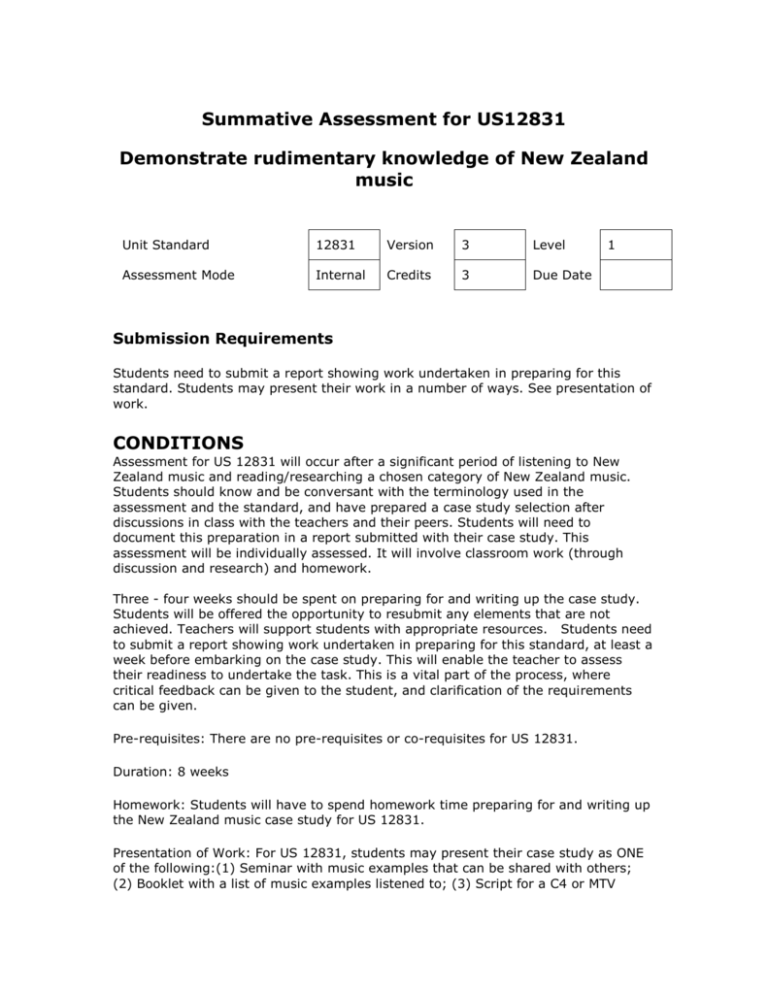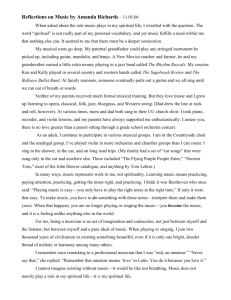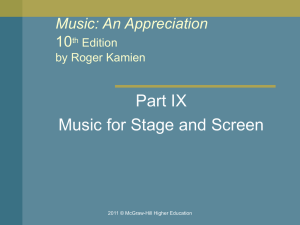Word file
advertisement

Summative Assessment for US12831 Demonstrate rudimentary knowledge of New Zealand music Unit Standard 12831 Version 3 Level Assessment Mode Internal Credits 3 Due Date 1 Submission Requirements Students need to submit a report showing work undertaken in preparing for this standard. Students may present their work in a number of ways. See presentation of work. CONDITIONS Assessment for US 12831 will occur after a significant period of listening to New Zealand music and reading/researching a chosen category of New Zealand music. Students should know and be conversant with the terminology used in the assessment and the standard, and have prepared a case study selection after discussions in class with the teachers and their peers. Students will need to document this preparation in a report submitted with their case study. This assessment will be individually assessed. It will involve classroom work (through discussion and research) and homework. Three - four weeks should be spent on preparing for and writing up the case study. Students will be offered the opportunity to resubmit any elements that are not achieved. Teachers will support students with appropriate resources. Students need to submit a report showing work undertaken in preparing for this standard, at least a week before embarking on the case study. This will enable the teacher to assess their readiness to undertake the task. This is a vital part of the process, where critical feedback can be given to the student, and clarification of the requirements can be given. Pre-requisites: There are no pre-requisites or co-requisites for US 12831. Duration: 8 weeks Homework: Students will have to spend homework time preparing for and writing up the New Zealand music case study for US 12831. Presentation of Work: For US 12831, students may present their case study as ONE of the following:(1) Seminar with music examples that can be shared with others; (2) Booklet with a list of music examples listened to; (3) Script for a C4 or MTV programme; (4) Website; (5) CD Rom or (6) Radio programme ELEMENTS AND PERFORMANCE CRITERIA FOR US12831 Element 1 Present a case study of one category of New Zealand music. Range: one of Mãori, ethnic music other than Mãori, popular, art music, music industry 1.1 Presentation provides brief chronological overview of study, including significant musicians and their contributions. 1.2 Presentation describes significant musical characteristics of selected study, including repertoire and performance style. 1.3 Presentation identifies features, which may be described as specifically ‘New Zealand’. Element 2 Present one aspect of the case study in detail. Range: one of: musical style, historical period, genre, activity 2.1 Presentation provides brief overview of aspect. 2.2 Presentation identifies musical features of aspect in terms of their significance to aspect and case study. Range - at least three musical features 2.3 Presentation identifies musicians of aspect in terms of their contributions to aspect and case study. Range - at least three musicians Element 3 Present an individual profile of one musician from the case study. Range: any New Zealand musician, alive or dead 3.1 Presentation provides historical setting of musician, including major influences on musician’s musical output. 3.2 Presentation provides brief musical biography of musician. Range - training, experience, compositions and/or performances 3.3 Presentation evaluates contribution of musician to New Zealand music history. Students seeking credit for this unit standard will be expected to submit a report showing work undertaken in preparing for this standard. US 12831 – Demonstrate rudimentary knowledge of New Zealand music STUDENT TASKS: Assessment Task 1.1 You are to present a case study of New Zealand Music. Choose ONE topic from: • Maori music • Ethnic music other than Maori (e.g. Pacific Island, Asian, Fijian Indian) • Popular music • Art music (e.g. ‘ serious’ /contemporary music – choral, orchestral, chamber, electronic etc) • Music Industry (e.g. Film/TV/radio music, musician engineers, music in the media, song writers etc) You may consider using the music we are listening to, analysing and playing in class. In any case, after you have chosen your topic, let your teacher know, so that they can support you with resources, information and helpful tips! 1.1 Provide a brief chronological overview of study, including significant musicians and their contributions. You will need: An opening paragraph stating what topic you have chosen with relevant information about this … and how you are going to narrow it down to something manageable that you will examine in more detail. Eg You might decide that you are going to do NZ Rock music, but narrow it down to 1960s pop music, which shows the influence of The Beatles for example. Then you would have to work out who the important Kiwi musicians of the 1960s were and investigate why they were important by looking at the things they did and the influence of their music (their contribution to the development of Kiwi rock music.) What ever you decide to do, all information must be presented in chronological order – this must be done as a time-line. Judgement Statement showing Evidence required to Achieve 1.1 Presentation provides brief chronological overview of study, including significant musicians and their contributions. This is evidenced through: • An opening paragraph • Key information shown as chronological time-line. Assessment Task 1.2 1.2 Describe the significant musical characteristics of selected study, including repertoire and performance style. Once you have narrowed down your topic of investigation, you now need to find lots of musical examples and listen carefully to all of them, listing your ideas using the following headings: • Main musical features of the music from the chosen era/topic of study. This should be a broad general statement. Eg in NZ pop music of the 1960s, the music was usually simple and catchy. Songs were short and had predictable structures. There were many solo acts. Rock n’ roll still had an influence on the styles of the music in terms of instruments used. NZ musicians tended to copy what was happening overseas, and there was very little originality… • Repertoire – list the key pieces of music and say why you think they were important. You may like to consider referring to the musical content of pieces to back up your comments on the musical features you have described, above. You may do this by: annotating a score, providing a recording accompanied by notes that explain the musical features and clearly refer to sections of the music using timings. E.g. From 1’ 12” – 1” 45” you can hear the ‘ ice cream’ chord progression. • Performance style – if you can, view videos of performances and describe the style of the music (eg soul) and the on-stage style of the performer(s) (eg Ray Columbus and the Invaders – these performers were static on stage, except for the classic 60s head movement. Dance movements were not innovative, and reflected learned patterns with very little original, ‘ free’ movement. Dress codes were very formal, reflecting the fact that NZ was concerned that pop idols would present a respectable image for teenyboppers to follow.) Judgement Statement showing Evidence required to Achieve 1.2 Presentation describes significant musical characteristics of selected study, including repertoire and performance style. This is evidenced through: • Relevant musical features are noted • Key repertoire list provided • Brief statements on performance style Assessment Task 1.3 1.3 Identify features, which may be described as specifically ‘ New Zealand’ You need to identify features of the music (refer to 1.2) that could be associated with the uniqueness of New Zealand. This may include: • Lyric content of songs (eg referring to aspects of Kiwi way of life) • Musical features that suggest an aspect of New Zealand (E.g. geography) • Performance venues (e.g. pubs, town halls, universities) Judgement Statement showing Evidence required to Achieve 1.3 Presentation identifies features, which may be described as specifically ‘ New Zealand’. This is evidenced through: • Brief discussion/personal response on considered interpretations of this element Assessment Task 2.1 From the information you have collected and written about, now choose and present ONE of the following aspects of the case study in detail. • Musical style (eg rock n’ roll, blues, soul, pop, disco, punk, serious, contemporary etc) • Historical period (eg 1960s pop) • Genre – which is a category of a music form that has a tradition or kaupapa and is identified by certain characteristics (eg opera, pop song, concerto, symphony) • Activity – eg making CDs/videos, touring, promotion, roadies etc Your presentation of this aspect must include: 2.1 A brief overview, you may summarise this using bullet points. You should include at least FIVE major points in this. (e.g. 1960s – The 1960s saw a loosening up of attitudes and morals. Rock and popular music was emerging, and parents were starting to become aware of the power of this phenomenon. NZ Rock stars were starting to emerge. It was an age of huge technological advance with the introduction of TV to NZ, and significant world events (eg assassination of President Kennedy, moon landing)… Judgement Statement showing Evidence required to Achieve 2.1 Presentation provides brief overview of aspect. This is evidenced through: At least five relevant points provided that show some understanding of the selected aspect. Assessment Task 2.2 2.2 identify at least THREE musical features of the aspect (eg genre) in terms of their significance and the relationship to the case study as a whole (eg 1960s pop). You need to be more specific here and back up your comments referring to music examples. Consider using the elements of music to help structure your ideas in this section. (e.g. In 1960s, NZ Pop music – tempi were usually pretty fast, to encourage dancing. Limbo Dancing was typical. Rhythm was regular and uncomplicated. Harmonies were uncomplicated, with few chords used, but repeated in progressions in the songs. Melodies were simple, repetitive, and memorable. The range was narrow. The instruments used were… . Judgement Statement showing Evidence required to Achieve 2.2 Presentation identifies musical features of aspect in terms of their significance to the aspect and case study. This is evidenced through: At least three musical features provided that show some understanding of the selected aspect and case study. Assessment Task 2.3 2.3 Identify at least THREE musicians in terms of their contributions to the chosen aspect (eg genre) and case study (eg 1960s pop). e.g. Three ‘ big’ musicians, that led the way in the 60s were… .. Musician A continued with using the typical features of 60s pop (as described above). This musician followed overseas trends, though sold xx thousand copies of sheet music, and stayed at number one for several weeks with their hit, “ NCEA Blues” . Musician B… … . Judgement Statement showing Evidence required to Achieve 2.3 Presentation identifies at least three musicians in terms of their contributions to aspect and case study. Assessment Task 3.1 The last thing to do is to choose and present an individual profile of one New Zealand musician (alive or dead) from the case study. The profile must provide: 3.1 The background of the musician, including major influences on musician’ s musical output. Here, you should state the styles of music that the musicians was in to, and relate this to the musician’ s own musical work. Make THREE clear and relevant statements. Judgement Statement showing Evidence required to Achieve 3.1 Presentation provides historical setting of musician, including major influences on musician’ s musical output. This is evidenced through: Clear and concise information on the background of the musician chosen including major influences on their style and musical output Assessment Task 3.2 3.2 Give a brief musical biography of musician, including training, experience, compositions and/or performances. Here, you should give dates of birth/death, family background, educational background, area(s) of interest, work experience, musical talents (eg instruments they play) and track their music career. List significant compositions/performances and the dates they were written/performed. Write a maximum of 200 WORDS on this. Judgement Statement showing Evidence required to Achieve 3.2 Presentation provides brief musical biography of musician. This is evidenced through: Clear and concise information on the training, experience, compositions and/or performances of the chosen musician Assessment Task 3.3 3.3 Provide an evaluation of the contribution of the chosen musician to New Zealand music history. Here you are to refer to critics who have made statements on their contribution to the NZ music scene. You should agree or disagree with such statements, giving clear reasons. You may also like to give your own personal view on this as well, as long as it is backed up with valid evidence from the music, or from other sources. Judgement Statement showing Evidence required to Achieve 3.3 Presentation evaluates contribution of musician to New Zealand music history. This is evidenced through: A brief, supported statement explaining the significance of the chosen musician within NZ music history AUTHENTICATION: The work that has been submitted for assessment is entirely my own work. Student signature Date: STUDENT COMMENT TEACHER'S COMMENT GRADE Resubmission Date: Student signature Date: Teacher's signature Date:






